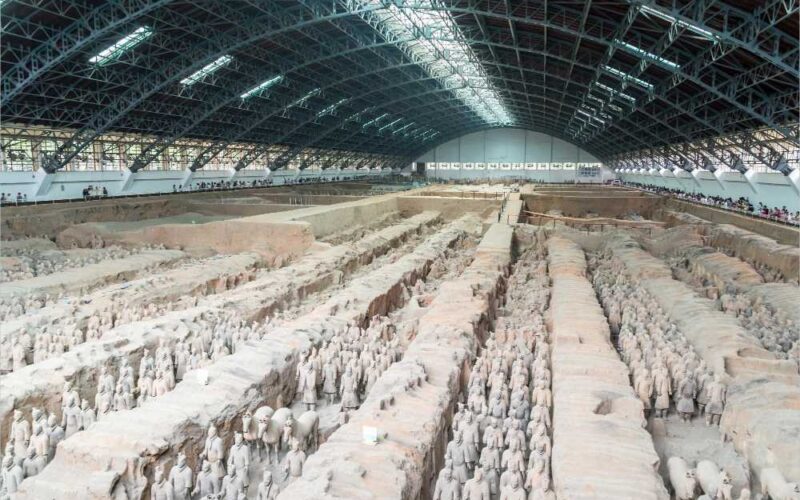The outstanding artistic achievements of Qin terracotta warriors and horses are the early masterpiece to impress the world. Their majestic momentum makes almost all visitors from different countries feel a strong tremor from the heart, which reflects the artist’s excellent ability to master the grand artistic theme and pursue the overall charm and artistic creation. This paper will interpret the art of the Terracotta Army in Qin Dynasty based on the historical values and cultural background of ancient China and argue the contribution of the Terracotta Army is reflecting the unique historical context and meanings rather than Emperor’s funeral objects.
At the first level of interpretation of the Terracotta Army, as Magli mentioned in the book “A Mound and A Terracotta Army” (Magli, 2020), at that time, it is generally believed that people can continue to live in another world after death, the spirit of the dead ascend to heaven and continue live in heaven, which underlies the Chinese conceptions of the afterlife. At the second level of interpretation, Qin Shihuang was the first emperor to abolish slavery, the first dynasty to establish a unified feudal society, the first person to unify the six countries, and the first to call himself Emperor. The Qin people have made amazing achievements in standardization practice. This reflection of standardization is not only a representative of the development of Qin people’s management art but also a symbol of the level of science and technology of the Qin Dynasty. The historical and cultural value of the terracotta warriors and horses is unique. It opened a window to observe the era it produced and greatly changed people’s views on that era.
The Cultural implication of the terracotta army
First of all, in terms of artistic features, there are also obvious differences between Qin figurines and Western sculptures. Due to the severe constraints of slavery, the ancient Egyptian statues were generally reflecting the king’s dignity and eternal concept. Also, Egyptian art served the purpose of holding the spirit of god or the deceased. (Mark, 2020) Another difference between them is the appearance of the sculptures. Through the anatomical proportion of the human body, the Terracotta army is military infantry and had a powerful appearance as they perform a well-arranged order, the army represents the epitome of the historical background of the Qin dynasty and the harmony of the cultures.
In addition, the terracotta warriors and horses in the mausoleum of Qin Shihuang are not only encyclopedias of modern archaeological science, but also typical representatives of tomb buildings. It has a direct impact on the thinking concept of feudal rulers, and provides abundant material remains for modern archaeologists to understand and study the history of the Qin Dynasty in terms of military organization and combat. (Yuan, 1990) Secondly, the army is considered the representative work of “ceramic culture” with unique Chinese national characteristics. This kind of early working people’s closeness to nature laid a solid foundation for the maturity of early plastic arts. The influence of this on the development direction of modern Chinese art was advancing during that period. The ceramic culture and plastic arts represented by it were born in Chinese people’s spirit along with the time. This ancient artifact makes modern people a deeper understanding of the life of ancient Chinese ancestors, it vividly reveals the customs, etiquette, military, political and cultural aspects of the Qin Dynasty from the aspects of clothing, food, housing and transportation. In general, the artistic miracle of the terracotta army of Qin mausoleum reflects the rich sensibility and creativity of Emperor Qin Shihuang, and profoundly reflects and reveals the characteristics of oriental civilization.
The development of new culture has not only affected our visual recognition but also interferes with our perceptions subconsciously. The design of the Terracotta army reflects and represents the ancient civilization of the Qin dynasty. From customs, etiquette, military, politics, as well as the wearing of terracotta warriors, it shows the prosperity of a generation of dynasty and symbol of the power of the feudal emperor. It not only makes people remember but people are also memorized by its great momentum. Like other arts of the Qin Dynasty, the art of the Terracotta Army is the summary of thousands of years of the artistic experience of the Chinese nation since the Neolithic age. Under the unified feudal autocracy, this experience had been fully developed and improved, sublimated into the unprecedented group art of pottery sculpture, making the art of sculptures of the army become a realistic and plastic art.
It is very important for a country’s art to have its personality, but it is more important to have its national characteristics. The Terracotta Army of Qin Shihuang Mausoleum is known as “the eighth wonder of the world” and reveals the national characteristics perfectly and vividly at that time. It not only has a distinct personality and strong characteristics of the times, but it also has rich historical and artistic values. Among them, the art of the terracotta warriors is of great significance in the history of Chinese sculpture and architecture and inherits and develops the traditional art and has an important influence on the creation and development of sculpture and architecture.
References
1. Major, John S, & Cook, Constance A. (2016). The rise and fall of the Qin dynasty. In Ancient China (pp. 197–214). Routledge. https://doi.org/10.4324/9781315715322-17
2. Man, J. (2009). The Terra Cotta Army. In The Terra Cotta Army. Da Capo Press.
3. Martinon-Torres, M., Bevan, A., Li, J., & X. (2018, March 9). The impact of China’s Terracotta Army on the dead and the living. Retrieved November, from https://www.thebritishacademy.ac.uk/blog/impact-chinas-terracotta-army-dead-and-living/
4. BURMAN, E. (2019). TERRACOTTA WARRIORS: History, mystery and the latest discoveries. Place of publication not identified: WEIDENFELD & NICOLSON.
5. Magli, G. (2020). A Mound and A Terracotta Army. In Sacred Landscapes of Imperial China (pp. 33–50). Springer International Publishing. https://doi.org/10.1007/978-3-030-49324-0_3
6. Mark, J. (2020, December 04). Ancient Egyptian Art. Retrieved December 09, 2020, from https://www.ancient.eu/Egyptian_Art/
